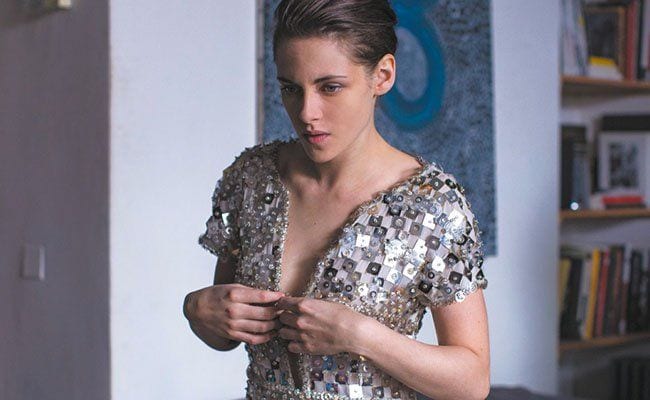
“When you don’t see the person you’re communicating with, it kind of fires up your imagination. It’s not that you’re connecting with an actual person, it’s more about projecting your fantasies onto another person who kind of agrees to be on the receiving end of them.”
“It’s an intuition thing. It’s a feeling. You see this door, it’s only, like, slightly ajar.” As she tries to describe what it’s like to be a medium, Maureen (Kristen Stewart) searches for words and images. The guy who’s asking, Ingo (Lars Eidinger), sits on the arm of a chair and watches her, his questions echoing your own, as you’ve seen Maureen approaching that door in previous scenes in Personal Shopper. “So,” he presses, “You think that the soul continues to exist after death?” Maureen shrugs, sits on a sofa adorned by large fur pillows, and looks away. “I’m not even sure if I believe in that.” A beat later, she lights the cigarette she’s been holding for the past two minutes, the smoke curls up into the frame.
The smoke, the fur pillows, and the window blinds behind Maureen create a mix of angles and textures. As the camera pushes in slowly and she looks back at Ingo, her perfectly pale face reflects the warm, pink and brown hues of the room. It’s a rich room, in the Paris apartment belonging to the fashion celebrity Kyra (Von Waldstätten), for whom Maureen works as a personal shopper and who’s having an affair with Ingo, an editor at Men’s Vogue. You can hear Kyra off screen, on a conference call in her bedroom arguing about an upcoming photo shoot. The noise floats over Maureen’s scene, suggesting another sort of communication, another metaphorical door slightly ajar.
Maureen exists between worlds. Shopping for Kyra, missing her recently dead twin brother Lewis, wishing she was “someone else”, Maureen appears alone again and again in Olivier Assayas’ film. She rides her motorbike in Paris streets blurred with lights at night, or takes the slick-surfaced train to London to shop for Kyra. Each scene cuts as she rides, impressionistic jump cuts that fracture her journey and your experience. The camera tracks her movements unevenly, trying to keep her in frame. If she doubts her own gift, she wants, she explains, to give her brother, who was a believer, the chance to contact her. And so, she says, whenever asked why she’s still in Paris she says, “I’m waiting.”
This means Maureen also exists between times, ever in motion and not moving on, inside and outside of moments. The film illustrates her dilemma with some familiar images — digital, haunting specters behind her, dark hallways before her — but it also makes it look new in her remarkable relationship with the camera. Maureen’s ongoing dance with the camera seduces you, because it is, after all, a dance with you. Personal Shopper features ghosts, murder, mysteries, and Maureen’s iPhone, but for all these familiar story bits, it’s a film that makes the most of, even expands, film as such. For all the rightful praise Stewart is receiving for her performance, it’s Stewart’s work with the camera here that’s remarkable.
The first scene in the movie sets up Maureen’s dance. A long take cranes up over a car as it approaches an iron gate, trees and fall leaves color the scene in browns and golds. She emerges from the car and walks toward the camera, now moved down to find her at eye level, hovering behind the gate. As she opens the gate and walks past it, the car passes her and the camera tracks along behind her, not quite keeping up. It’s a brilliant first gesture, indicating that she will be elusive, not exactly in sync with the frame but in touch with it. Her figure, clothed in dark pants and jacket, is slender, and only one of the elements on the screen, which remains suffused with brown and gold, the trees and the road blending together.
This delicate relationship between Maureen and the camera persists. Inside the house at night, she waits for a sign from her brother. She paces through the house, looking, the camera following and then anticipating her gaze, the light dimming as her hope combines with your dread. At this point, you don’t know what she wants. Even as her quest becomes better articulated, in conversations throughout the film, her desire shifts and the camera never proposes that she comes to decisions or destinations.
As she shops, for her desires and for Kyra’s outfits, Maureen takes the bus or rides escalators, people around her look more like architectural backdrop than individuals. As she rides, she seeks solutions in media as well as the world around her. It’s fair to say that the film understands media as the world around her, another portal through which she and you might step. She watches videos, she looks up art, she reads addresses and names. She texts. When, partway through Personal Shopper, Maureen is contacted by an “unknown number”, she’s intrigued and perplexed, guessing at the possibilities. Is it Lewis? Is it her own desire getting the better of her? Is it a stalker with ill intent?
The resolution of this mystery is less compelling than the questions it generates, her new self-understanding, the risks she finds herself able to take. Neither is the resolution the end of the film or Maureen’s movement. She persists, the camera hovers near her. And she asks more profound questions.

